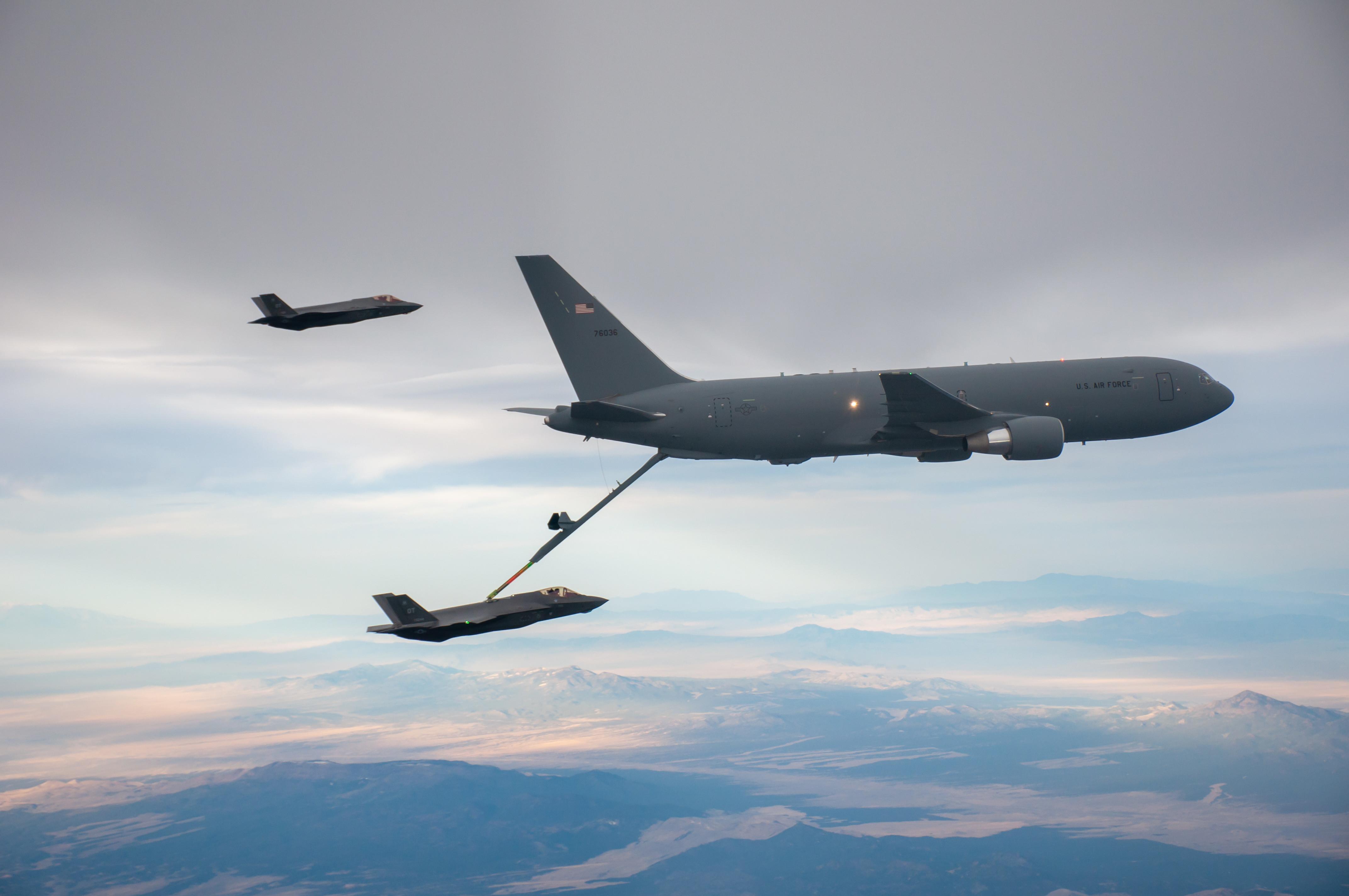
Despite the fact that it won’t be declared operational for at least another two years, the Boeing KC-46A has flown thousands of operational missions and offloaded tens of millions of pounds of fuel under a plan that has freed up the troubled tanker to refuel 97% of receiver aircraft.
Air Mobility Command (AMC) on June 1 announced the latest rollout of its Interim Capability Release (ICR) plan for the KC-46, allowing it to be tasked by U.S. Transportation Command to refuel the B-1B, C-135 variants, E-8, EC-130H, F-35B/C, KC-10 and P-8. As of June 2, the service has 59 KC-46s, with more expected to be delivered this month.
The command announced the ICR effort last year as a way to relieve stress on the KC-135 and KC-10 fleets. The KC-46 still has severe deficiencies with its Remote Vision System and a “stiff boom” problem that prevents it from refueling small and slower aircraft such as the A-10, but AMC and its aircrews felt comfortable enough with the tanker as it flies now to pick up missions.
“ICR is designed to be a very conservative program,” Brig. Gen. Ryan Samuelson, the KC-46 cross functional team lead, tells Aviation Week. “We didn’t want to step out and employ an aircraft we knew had deficiencies, that we didn’t feel like we have fully analyzed that the crew could get the mission done safely.”
Since the ICR plan started in July 2021, KC-46s have flown more than 3,000 operational missions, offloading 66 million lb. of fuel in more than 16,000 contacts with the refueling boom and 1,000 contacts with the drogue.
The process of clearing an aircraft to operationally receive fuel from the KC-46 can be lengthy. For example, E-4B Nightwatch crews at Offutt Air Force Base, Nebraska, told Aviation Week in mid-April that their aircraft recently wrapped up tests with the tanker. This included initial contacts between the aircraft at the Air Force Operational Test and Evaluation Center. That technical data is processed by both the KC-46 System Program Office and the Air Force’s Air Refueling Certification Agency, which both need to give an OK. Then, operational crews fly familiarization flights and exercises with the receiver aircraft. Finally, the commanders of Air Mobility Command, the Air National Guard and Air Force Reserve will approve the receiver, Samuelson says.
In addition to the U.S., seven other countries have also cleared some of their aircraft to refuel with the KC-46. Earlier this year, four KC-46s deployed to Spain in an exercise that AMC designed to refine its tactics and plans for the aircraft in addition to validating the tankers abroad. In about 1 1/2 months, the tankers flew 81 missions totaling 536.3 hr., offloading 2 1/2 million lb. of fuel to 155 aircraft including Spanish F-18s, and supporting U.S. fighters that were deploying to Europe for air policing missions on NATO’s eastern front.
“Allies asking for a while, hey, we’d love to certify our aircraft against your KC-46 and we finally felt that we were in a position to do that,” Samuelson says of training with allies.
The Boeing E-7A is also undergoing tests with the KC-46 ahead of both clearance for allied operators to receive fuel from the tanker and before the U.S. Air Force itself plans to buy the Wedgetail. Royal Australian Air Force E-7s have flown in multiple exercises inside the U.S. this year.
Though the vast majority of U.S. receivers are cleared under the ICR, that number will not reach 100% because the A-10 cannot be cleared to refuel from the KC-46 in light of the “stiff boom” deficiency. The Air Force and Boeing are redesigning an actuator with that design to be completed in fiscal 2024, with retrofits to come after.
While the KC-46 is cleared for most operations, initial and full operational capability is also years away because AMC will not declare these milestones until the new Remote Vision System is completed and installations begin in 2024. The current RVS 1.0 has several serious deficiencies affecting operations, with washed out areas or deep shadows on displays that can cause boom impacts outside the receiver’s refueling receptacle.
“Until that visual system is upgraded, AMC does not have a plan to declare this aircraft fully operationally capable,” Samuelson says. “However, does that mean you won’t see the KC-46 around the world filling [aerial refueling] mission sets? No. It means you will see that, it’ll just be a measured risk.”
Like the deployment to Europe earlier this year, AMC is planning similar exercises across the globe to come soon. KC-46s will deploy to the Pacific for exercise Valiant Shield starting this month, with a deployment to the Middle East to follow.
These missions are also shaping the Air Force’s design for operational units. The command is increasing the number of aircrews per tail to a 2.0 ratio, which is equal to that of the KC-10 and higher than the 1.75 ratio on the KC-135, meaning there will be 24 aircrews for 12 jets in a squadron. The command expects the new KC-46 will keep a high readiness rate and operate more often.
“What that does is, like most newer aircraft, we’re hoping that the ability of the aircraft to fly its missions and maintain a higher maintenance reliability rate is there so that you can turn the aircraft and you can utilize it, it’s not being down for parts or other opportunities,” Samuelson says.






Comments